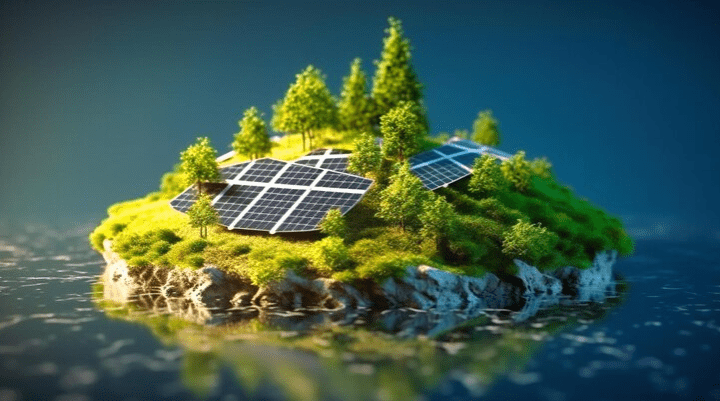Green Solar Energy Technology Advancements
The field of green solar energy is rapidly evolving, with new technologies and improvements emerging regularly. These advancements are making solar power more efficient, affordable, and accessible. Let’s explore some of the key areas of technological progress in the solar industry.
Improved Solar Panel Efficiency
One of the most significant areas of advancement in green solar energy is the continual improvement in solar panel efficiency. Higher efficiency means more power can be generated from the same amount of sunlight, making solar installations more productive and cost-effective.
Latest Developments in Photovoltaic Technology
- Multi-junction Solar Cells: These cells use multiple layers of light-absorbing materials to capture a broader spectrum of sunlight. While more expensive, they can achieve efficiencies of over 40% in laboratory settings.
- Passivated Emitter and Rear Cell (PERC) Technology: PERC cells include an additional layer on the back of the cell that reflects unabsorbed light back through the cell, increasing efficiency by 1-2 percentage points.
- Bifacial Solar Panels: These panels can absorb light from both sides, potentially increasing energy production by 10-30% compared to traditional monofacial panels.
- Tandem Solar Cells: By stacking different types of solar cells, tandem configurations can achieve higher efficiencies. For example, perovskite-silicon tandem cells have reached efficiencies of over 29% in lab settings.
Here’s a table showing the evolution of solar cell efficiencies over time:
| Year | Best Research Cell Efficiency |
|---|---|
| 1954 | 6% (Silicon) |
| 1985 | 20% (Silicon) |
| 2000 | 25% (Silicon) |
| 2015 | 29% (GaAs) |
| 2020 | 47% (Multi-junction concentrator) |
Thin-Film Solar Cells
Thin-film solar cells represent another area of technological advancement:
- Flexibility: Can be applied to curved surfaces or integrated into building materials.
- Lower Production Costs: Require less material and energy to produce than traditional silicon cells.
- Types: Include amorphous silicon (a-Si), cadmium telluride (CdTe), and copper indium gallium selenide (CIGS).
While thin-film cells typically have lower efficiency than crystalline silicon cells, their unique properties make them suitable for specific applications, such as portable solar chargers or building-integrated photovoltaics.
Energy Storage Solutions
Advancements in energy storage are crucial for maximizing the potential of green solar energy, addressing the intermittency issue inherent in solar power generation.
Battery Technologies for Solar Energy
- Lithium-Ion Batteries: Currently the most common type of battery used in solar energy storage. They offer high energy density, long cycle life, and decreasing costs.
- Flow Batteries: These batteries store energy in liquid electrolytes, making them easily scalable for large installations. They have a long lifespan and can provide power for extended periods.
- Solid-State Batteries: Still in development, these promise higher energy density and improved safety compared to liquid electrolyte batteries.
- Sodium-Ion Batteries: A potentially cheaper alternative to lithium-ion, using more abundant materials.
Case Study: Tesla Powerwall
Tesla’s Powerwall has become one of the most recognizable home battery systems. The Powerwall 2, released in 2016, offers 13.5 kWh of energy storage and up to 7 kW of peak power output. It can be used to store excess solar energy during the day for use at night or during grid outages. In areas with time-of-use electricity rates, the Powerwall can help homeowners save money by storing cheap off-peak energy for use during expensive peak hours.
Grid Integration and Smart Grids
Advancements in grid technology are enabling better integration of solar energy:
- Smart Inverters: These can communicate with the grid to help balance supply and demand, improving grid stability.
- Microgrids: Small-scale grids that can operate independently or in conjunction with the main grid, enhancing resilience and enabling local energy management.
- Virtual Power Plants (VPPs): Networks of decentralized power-generating units like solar panels and batteries, coordinated to deliver power to the grid as if they were a single power plant.
Smart grid technologies are enabling more efficient use of solar energy:
- Real-time Monitoring: Allows for better matching of supply and demand.
- Predictive Analytics: Uses weather forecasts and historical data to predict solar energy production.
- Demand Response: Encourages consumers to reduce energy use during peak times, often through automated systems.
These technological advancements are making green solar energy more efficient, reliable, and grid-friendly. As research continues and economies of scale drive down costs, we can expect even more impressive innovations in the coming years, further cementing solar power’s place as a cornerstone of our sustainable energy future.
In the next section, we’ll explore how individuals can implement green solar energy in their homes, taking advantage of these technological advancements to reduce their carbon footprint and energy costs.
Government Policies and Incentives for Green Solar Energy
Government support plays a crucial role in the widespread adoption of green solar energy. Various policies and incentives at federal, state, and local levels aim to make solar power more accessible and affordable for both individuals and businesses. Understanding these policies can help you maximize the benefits of going solar.
Federal Tax Credits and Rebates
The U.S. federal government offers significant incentives for solar adoption, primarily through the Investment Tax Credit (ITC).
Solar Investment Tax Credit (ITC)
The ITC is one of the most important federal policy mechanisms to support the deployment of solar energy in the United States.
- Current Rate: As of 2023, the ITC provides a 30% tax credit for solar systems installed on residential and commercial properties.
- Duration: The 30% rate is set to continue through 2032, then step down to 26% in 2033 and 22% in 2034.
- Eligibility: Both residential and commercial solar installations qualify.
- Application: The credit is applied to the income tax liability of the system owner.
Here’s how the ITC works in practice:
| System Cost | Tax Credit (30%) | Net Cost After ITC |
|---|---|---|
| $10,000 | $3,000 | $7,000 |
| $20,000 | $6,000 | $14,000 |
| $30,000 | $9,000 | $21,000 |
How to Qualify and Apply
- Ownership: You must own the solar system (not lease it) to claim the ITC.
- Installation Date: The credit can be claimed for the tax year in which the system was installed.
- Application Process: Use IRS Form 5695 for residential installations or Form 3468 for commercial installations when filing your tax return.
- Carry Over: If you can’t use the entire credit in one year, the excess can generally be carried forward to future tax years.
State and Local Incentives
In addition to federal incentives, many states and local governments offer their own programs to encourage solar adoption. These can vary significantly by location but may include:
- State Tax Credits: Similar to the federal ITC, but at the state level.
- Cash Rebates: Upfront reductions on the cost of your solar system.
- Solar Renewable Energy Certificates (SRECs): Earned for every megawatt-hour (MWh) of electricity your system produces, which can be sold for additional income.
- Property Tax Exemptions: Many states exclude the added value of a solar system from property tax assessments.
- Sales Tax Exemptions: Some states waive sales tax on solar equipment purchases.
Net Metering Policies
Net metering is a billing mechanism that credits solar energy system owners for the electricity they add to the grid. Policies vary by state:
- Full Retail Net Metering: Credits are given at the full retail rate of electricity.
- Time-of-Use (TOU) Net Metering: Credits vary based on the time of day electricity is produced.
- Net Billing: Excess generation is credited at a lower rate than the retail rate.
Case Study: California’s Net Metering Policy
California’s Net Energy Metering (NEM) program has been crucial in driving solar adoption:
- Under NEM 2.0 (current policy), customers receive credits for excess energy at close to the retail rate.
- Customers are on a time-of-use (TOU) rate plan, encouraging energy use when rates are lower.
- The program has helped California become the leading state in solar installations, with over 1.3 million solar projects as of 2023.
Example of Combined Incentives
Let’s look at how federal, state, and local incentives might combine for a hypothetical residential installation in New York:
- System Cost: $20,000
- Federal ITC (30%): -$6,000
- NY State Tax Credit (25% up to $5,000): -$5,000
- NYSERDA Rebate ($0.20/W up to 25kW): -$1,000
- Net Cost: $8,000
In this example, the homeowner saves 60% on the total system cost through various incentives.
Staying Informed About Incentives
Given the dynamic nature of solar policies and incentives, it’s crucial to stay informed:
- Database of State Incentives for Renewables & Efficiency (DSIRE): A comprehensive source for information on incentives and policies that support renewable energy in the United States.
- Local Solar Installers: Often have up-to-date information on local incentives and can help you navigate the application process.
- State Energy Offices: Provide information on state-specific solar programs and incentives.
- Utility Companies: May offer additional rebates or incentives for solar adoption.
Government policies and incentives have been instrumental in making green solar energy more accessible and affordable. By taking advantage of these programs, individuals and businesses can significantly reduce the upfront costs of solar installation and accelerate their return on investment. As we continue to prioritize renewable energy, it’s likely that these supportive policies will evolve, potentially offering even greater benefits for solar adopters in the future.
In the next section, we’ll address some of the challenges in green solar energy adoption and explore strategies to overcome them.
The Future of Green Solar Energy
As we look ahead, the future of green solar energy is bright and filled with potential. Emerging technologies, innovative applications, and increasing global commitment to renewable energy are set to transform the solar industry. Let’s explore some of the exciting developments on the horizon.
Emerging Technologies
The solar industry is continuously innovating, with several promising technologies poised to increase efficiency and expand applications.
Perovskite Solar Cells
Perovskite solar cells represent one of the most exciting advancements in solar technology:
- Efficiency: Lab efficiencies have reached over 29%, rivaling traditional silicon cells
- Cost: Potential for significantly lower production costs than silicon cells
- Flexibility: Can be printed on flexible substrates, opening up new applications
- Challenges: Improving stability and scaling up production
Here’s a comparison of perovskite progress against other solar cell types:
| Solar Cell Type | Best Research Cell Efficiency | Typical Commercial Efficiency |
|---|---|---|
| Perovskite | 29.15% | Not yet commercialized |
| Monocrystalline Silicon | 26.7% | 17-22% |
| Polycrystalline Silicon | 22.3% | 15-17% |
| Thin-film (CdTe) | 22.1% | 14-16% |
Solar Windows and Roads
Integrating solar technology into everyday surfaces could dramatically increase solar energy production:
- Solar Windows:
- Transparent solar cells that can turn windows into power generators
- Potential applications in skyscrapers and residential buildings
- Current efficiencies around 5%, but improving rapidly
- Solar Roads:
- Road surfaces embedded with durable solar panels
- Can potentially generate power while serving as functional roadways
- Challenges include durability, cost, and efficiency under real-world conditions
Case Study: Solar Roadways in France
In 2016, France installed a 1-kilometer stretch of solar road in Normandy:
- 2,800 square meters of solar panels
- Initial energy production goal: 280 MWh per year
- Actual results: Underperformed due to damage from traffic and weather
- Lessons learned: Highlighting the challenges of implementing solar roads and the need for further technological development
Integration with Other Renewable Sources
The future of green energy lies in the intelligent integration of multiple renewable sources.
Hybrid Systems
Combining solar with other renewable energy sources can provide more consistent and reliable power:
- Solar + Wind:
- Complementary generation patterns (wind often stronger at night)
- Can share inverters and transmission infrastructure
- Solar + Hydroelectric:
- Solar can complement hydroelectric during dry seasons
- Pumped hydro storage can store excess solar energy
- Solar + Biomass:
- Biomass can provide baseload power when solar is unavailable
- Particularly useful in agricultural areas
Microgrids and Smart Energy Management
Microgrids represent a decentralized approach to energy distribution, often incorporating multiple renewable sources:
- Definition: Localized grids that can disconnect from the traditional grid to operate autonomously
- Benefits: Increased resilience, efficiency, and integration of renewable sources
- Smart Management: AI and machine learning algorithms optimize energy flow and storage
Here’s a table illustrating the components of a typical microgrid:
| Component | Function |
|---|---|
| Solar Panels | Primary energy generation |
| Wind Turbines | Complementary energy generation |
| Battery Storage | Energy storage for use during low generation periods |
| Smart Inverters | Convert DC to AC and manage power flow |
| Control System | Optimize energy use and generation |
| Connection to Main Grid | For backup power and selling excess energy |
Global Impact of Green Solar Energy
The increasing adoption of solar energy worldwide is having profound effects on both developed and developing nations.
Solar Energy in Developing Countries
Solar power is playing a crucial role in bringing electricity to remote and underserved areas:
- Off-grid Solutions:
- Solar home systems providing basic electricity needs
- Mini-grids powering entire villages
- Economic Benefits:
- Job creation in solar installation and maintenance
- Enabling new economic activities through access to electricity
- Health Improvements:
- Replacing kerosene lamps with solar lighting, reducing indoor air pollution
- Powering medical equipment in remote clinics
International Cooperation and Agreements
Global initiatives are accelerating the adoption of solar energy:
- Paris Agreement:
- Goal to limit global temperature increase to well below 2°C above pre-industrial levels
- Many countries include solar energy in their Nationally Determined Contributions (NDCs)
- International Solar Alliance (ISA):
- Coalition of 121 countries, mostly sunshine countries
- Aims to mobilize $1 trillion in investments for solar energy by 2030
- Technology Transfer:
- Sharing of solar technology and best practices between developed and developing nations
Predictions for the Future
While predicting the future is always uncertain, several trends seem likely based on current trajectories:
- Continued Cost Reductions:
- Solar electricity is projected to become the cheapest form of energy in most parts of the world
- Bloomberg New Energy Finance predicts 77% cost reduction for solar PV by 2050
- Increased Efficiency:
- Commercial solar panel efficiencies expected to reach 24-25% by 2030
- Multi-junction cells may achieve 50% efficiency in the coming decades
- Ubiquitous Integration:
- Solar cells integrated into building materials, vehicles, and consumer electronics
- Potential for solar-powered Internet of Things (IoT) devices
- Advanced Grid Integration:
- AI-powered smart grids optimizing the balance between solar, other renewables, and energy storage
- Virtual power plants coordinating thousands of distributed solar systems
- Space-Based Solar Power:
- Long-term potential for collecting solar energy in space and beaming it to Earth
- Could provide consistent power regardless of weather or time of day
The future of green solar energy is incredibly promising. As technology advances, costs decrease, and global commitment to renewable energy grows, solar power is poised to play an increasingly central role in our energy landscape. The challenges are significant, but so are the potential rewards of a cleaner, more sustainable energy future powered by the sun.
Conclusion
As we conclude our comprehensive exploration of green solar energy, it’s clear that this technology stands at the forefront of our transition to a sustainable energy future. From its environmental benefits to its economic advantages, solar power offers a compelling solution to many of our energy challenges.
Recap of the Importance of Green Solar Energy
Let’s revisit the key reasons why green solar energy is crucial for our future:
- Environmental Impact: Solar energy significantly reduces carbon emissions and air pollution, helping to mitigate climate change and improve air quality.
- Energy Independence: By harnessing the sun’s power, countries and individuals can reduce their reliance on fossil fuels and foreign energy sources.
- Economic Benefits: The solar industry creates jobs, stimulates economic growth, and can lead to significant savings on energy costs for consumers and businesses.
- Technological Innovation: Ongoing advancements in solar technology are driving efficiency improvements and cost reductions, making solar increasingly accessible.
- Versatility: From large-scale solar farms to small residential installations, solar energy can be adapted to a wide range of applications and scales.
Call to Action for Readers
As we face the global challenge of transitioning to clean energy, every individual has a role to play. Here are some ways you can contribute to the solar energy revolution:
- Consider Solar for Your Home or Business:
- Evaluate your property’s solar potential and explore installation options.
- Even if you can’t install solar panels, look into community solar projects in your area.
- Educate Yourself and Others:
- Stay informed about solar technology and policy developments.
- Share your knowledge with friends, family, and colleagues to spread awareness.
- Support Solar-Friendly Policies:
- Advocate for solar-friendly legislation and incentives in your local community and at the state and federal levels.
- Invest in Solar:
- Consider investing in solar companies or funds if it aligns with your financial goals.
- Reduce Energy Consumption:
- Implement energy-efficient practices in your daily life to complement solar energy efforts.
Final Thoughts on the Future of Sustainable Energy
As we look to the future, it’s clear that green solar energy will play an increasingly vital role in our global energy mix. The rapid pace of technological advancement, coupled with growing public and political support for renewable energy, paints a promising picture.
However, the transition to a solar-powered future is not without its challenges. Issues such as energy storage, grid integration, and equitable access to solar technology will require ongoing attention and innovation. Yet, with each passing year, we see these challenges being addressed with ingenious solutions and unwavering determination.
The story of green solar energy is one of human ingenuity and our capacity to harness nature’s power for the greater good. It represents our ability to innovate in the face of environmental challenges and our commitment to creating a sustainable world for future generations.
As we stand on the cusp of this solar revolution, we are reminded of a quote by solar pioneer Denis Hayes:
“Solar power is the last energy resource that isn’t owned yet – nobody taxes the sun yet.”
This sentiment encapsulates the democratic and abundant nature of solar energy. It’s a resource that, with the right approach, can be accessible to all, promising a future where clean, affordable energy is not a luxury, but a fundamental right.
In embracing green solar energy, we’re not just adopting a new technology; we’re championing a new way of thinking about our relationship with energy and our planet. It’s a path that leads us towards a more sustainable, equitable, and bright future – powered by the limitless energy of the sun.
As we conclude, remember that every solar panel installed, every policy supported, and every conversation about renewable energy contributes to this global shift. The future of energy is in our hands, and it’s shining brightly with the promise of green solar power.




